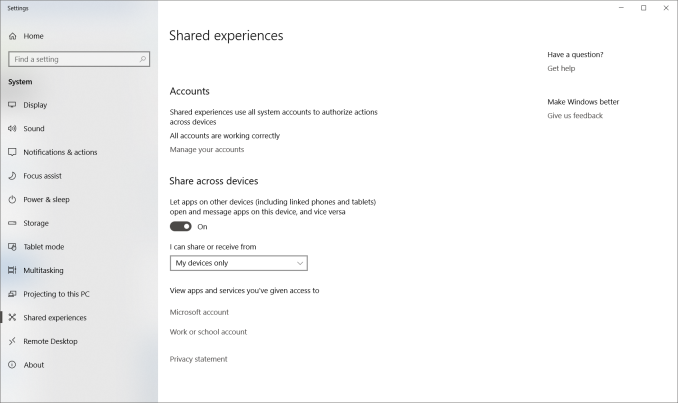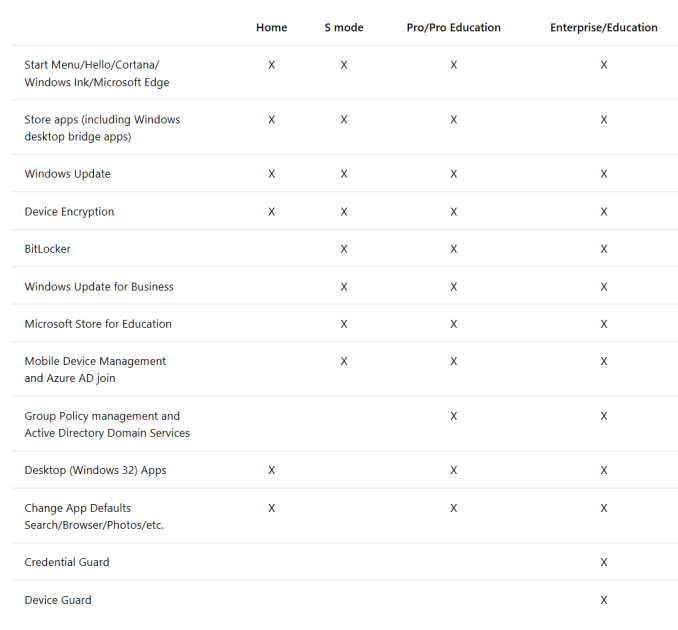The Windows 10 April Update (1803): The Littlest Big Update
by Brett Howse on May 25, 2018 8:00 AM EST- Posted in
- Software
- Operating Systems
- Windows
- Microsoft
- Windows 10
Nearby Share
One feature that should be very useful to certain people is Nearby Share. This lets you quickly and easily share files between people from PC to PC, without having to send an email or use a messaging app as the transfer tool. Nearby Share works over Bluetooth or Wi-Fi, and will use Wi-Fi as the preference. In an office, this was something done via a USB drive most recently, but with wireless and Bluetooth in all modern laptops, it makes sense to leverage that to avoid a step.
It should be very useful in certain situations, and isn’t tied to an account so you can send to any nearby device. The receiver will have the option of accepting the file. It’s not on by default, but can be toggled on when needed. It’s definitely something you’d not want to leave on.
Easy Bluetooth
Windows 10 now supports a simpler Bluetooth pairing process for some devices which lets you pair devices with a single click. You’ll get a pop-up notification asking if you want to pair a device, and if you say yes, it’s all setup. Devices have to support this though, and ones that require PINs are not going to work with a single click setup.
Windows 10 S Mode
Windows 10 S launched with the Surface Laptop as its first device to offer the constrained version of Windows 10 that restricts users to only running apps from the Store. The idea was to keep people from harming themselves, and to keep performance levels where they should be, by not allowing people to just install whatever they want, and to keep apps in packages that allow for easy removal and less items running at startup. This is pretty much how any modern smartphone works of course, but the downside to it on Windows 10 was that the Microsoft Store is not known as one of the key selling features, so uptake and usuage of Windows 10 S had to be pretty small. With the April Update, this is replaced by Windows 10 in S Mode, which is just a setting that can be enabled on any PC to make it like Window 10 S was. It'll still likely never get used, but it's a much better solution than another version of the OS just for this purpose. There's reasons you'd want this of course - education being a great example - but the average consumer is choosing Windows for the legacy application support, so this new model is definitely the better way to handle it.
The drawback is that S Mode is a one-way setting at the moment. A machine can be set in S mode when imaged using an unattended.xml file and dism, but if it's set back to regular Windows 10, there's not a way to switch back and forth.












161 Comments
View All Comments
damianrobertjones - Friday, May 25, 2018 - link
Backups can be your friend.voicequal - Saturday, May 26, 2018 - link
Update to 1709 also lost the WHS/Essentials connector for me. Doing my best to defer 1803 until 1709 EOL, or until I actually need one of the new features.damianrobertjones - Friday, May 25, 2018 - link
Updated a load in work, all my home computers, all without issues. Sucks to be you if you did. The millions of people that have no issues seldom say stuff.Zan Lynx - Saturday, May 26, 2018 - link
I did four machines. They all updated without problems.bill44 - Friday, May 25, 2018 - link
When can we expect a proper color management system in Windows 10?Been waiting 2+ years, it's been promissed several times, but now the topic is dead.
Wih wide gamut displays, 10bit color, HDR, we need something better (Apple colorsync?) than sRGB 8bit SDR on our desktop. First, proper color managent, then sort out the current HDR mess.
3D Dynamic LUT support would be nice!
serendip - Friday, May 25, 2018 - link
My Windows Atom tablet has a display bug with the latest update that's probably related to the Intel GPU driver. When using the built-in Windows movie viewer, the screen blanks out for a few seconds when starting and stopping viewing. It doesn't happen with VLC.DiscoDJ - Saturday, May 26, 2018 - link
I own a small computer business in a town of 55k people. Since May 22nd we've had three cases of customers calling and complaining of issues after a Windows Update. I'm have no way of knowing if the update involved is 1803 or the 5-18 monthly update.All 3 machines have suffered from failure of the user account to load properly. You end up at a black screen with no icons other than recycle bin.
Clicking on anything does nothing. Right clicking...ditto. Keyboard commands work, but I haven't found any combination that will fix this.
So I pulled the HDDs (not SSDs) and backed up the user data and reinstalled Windows.
At that point I noticed something interesting. There were extra partitions on the each HDD that were not standard to the factory install (2 HPs, 1 Dell.). It was like the update was creating a new partition before installing.
I am admittedly confused, but like I said, reinstalling Windows from scratch (including all updates) solved the issue, and didn't cause any further issues.
Gunbuster - Saturday, May 26, 2018 - link
it is a reinstall. that's why you get a windows.old dir too. they should not be calling it an updateChristopherFortineux - Friday, June 8, 2018 - link
The extra partitions are for roll-back.B3an - Saturday, May 26, 2018 - link
I wish someone would benchmark Win 10 April Update compared to the original Win 10 release. Would be interesting to see if anything has improved at all. And i mean from gaming to app loading times, start up times, battery life and network performance.